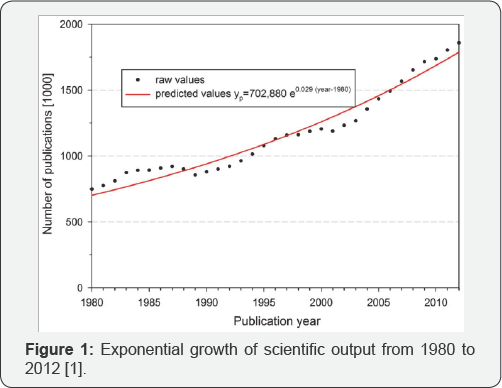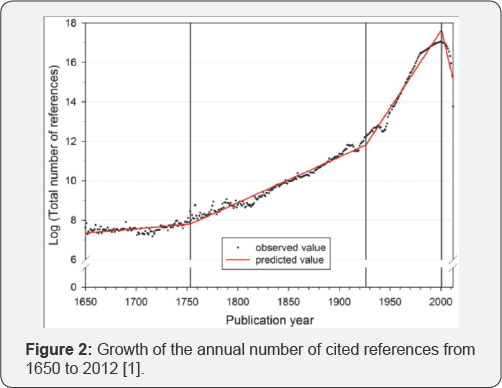Publications: A Viable Vehicle for Dissimulation of Knowledge or a Vital Statistic for Generation of Publishers' Income? - Juniper publishers
Journal of Trends in Technical and Scientific Research
Abstract
The quality and number of publications have long been
considered as a vital foundation component to support the tenue and/or
promotion of an academic and his career. It is also an important process
to dissimulate research results for the benefits of academia, industry,
government and the public. The process is particularly important and of
public interest if the research published is supported by public funds.
Throughout the past few decades, the number of publications produced by
an academic institution has become an indication of the research
strength of the institution and a vital statistic in the academic
ranking of the institution worldwide. However, all the statistical data
and ranking criteria are primarily under the control of publishers. As a
result, publication of research papers and the statistical tools for
the analysis of relative importance of these published works have become
income generators of the publishers, resulting in the exponential
increase in the number of research papers but significant deterioration
of their quality. Such malpractice also has tremendous impact on the
academic ecology.
Introduction
Higher education is being transformed continuously by public policies and societal forces for the good and the bad [1].
The number of academic institutions is increasing exponentially
worldwide. Many traditional values of higher education are diminishing
in face of rapid technological developments and mounting economic
pressure. Fees and research funds are the two major regular income
sources of most academic institutions. Academic institutions are thus
spending much more effort on recruitment of students, in particular
foreign students or out-of-state students in the U.S., for the
generation of income from fees to support the operating expenses of the
institution. Faculty members are also under tremendous pressure to
secure research funding. The situation can be acute for private
institutions, and public institutions are not in a much better position
due to diminishing public support for higher education [1].
Improvement of the global ranking of the institution may be an easy
path to succeed in both approaches for increasing the institution's
income. The easiest way to manipulate the ranking system is by ways of
publications and citations, resulting in the exponential increase in the
number of research papers but significant deterioration of their
quality. Moreover, the academic ecology has also been significantly
deteriorated in the process.
The publication game
Academic publications are supposed to dissimilate
research results for the benefits of academia, industry, government and
the public. The contents of publications are supposed to be accurate, of
interest to the readers and worthy publishing. In the 1980s, an
assistant professor with 15-20 quality journal papers could probably be
awarded tenure and promotion in many reputable universities in the U.S.
However, in the 2010s, a doctoral student in Asia may have published
more than 20 journal papers before filing his dissertation. An obvious
question is: How can the research of a doctoral student be of the
quality and quantity to publish so many papers of interest to the
readers and worthy publishing? A more fundamental question is: Has the
process of publication become a game? My answer to the question is
affirmative. More importantly, the game is fueled by university
administrators and publishers, and the situation is worsening in many
parts of the world, in particular Asia.
Researchers prepare manuscripts on their research
results and submit them to publishers for possible publication without
any monetary benefits. Reviewers review the submitted manuscripts on a
voluntary basis. Most editors and members of the editorial boards
handling the technical aspects of manuscripts are volunteers. Therefore,
the costs of manuscript preparation and review prior to publication are
minimal to the publisher. After acceptance of the manuscripts,
publishers bear the costs of copyediting, printing and distribution of
the resulting publications but they reap all the monetary benefits of
the publications. The subscription cost paid by libraries for these
academic publications are considerably higher than their printing and
distribution costs, resulting in a significant profit margin to the
publishers. More publications would thus translate to more income. It is
a trend in the publication industry that many publishers are holding
annual meetings in expensive hotels serving exquisite lunches with
researchers in different Asian cities to promote the publication
industry.
Digestive tools are required to analyze, understand
and dissimulate such a vast volume of publication data. As a result, the
publishers develop websites, statistical tools, databases, indices etc.
to analyze and quantify the publication data already in their control.
More importantly, academic institutions have to subscribe to these
websites, statistical tools, databases etc., creating new income sources
for the publishers.
It should be recognized that it is extremely
difficult, if not impossible, to measure the quality of publications
accurately and objectively. Nonetheless, the number of publications and
the number of cited references of these publications become the two most
objective statistical indicators of the quality of publications. The
number of Nobel Laureates of an academic institution is obviously not
correlated to the number of publications or the number of cited
references of the institution. It is quite obvious that the number of
publications or the number of cited references generated by an academic
institution is no measure of her real research strength. However, these
statistics become the driving force for publications and cited
references. It is evident that the annual number of publications has
grown exponentially in recent years as shown in Figure 1 [2]. Moreover, the annual number of cited references has grown at an even faster rate as shown in Figure 2 [2].


Impact
University administrators always praise researchers
of high productivity in terms of quantity but not quality, and high
citation index. The practicality and reasonableness of such high
publication productivity has never been questioned. It is quite obvious
that the publication productivities of these researchers are higher
those of fiction writers, indicating it is practically impossible to
conduct any quality research. Senior faculty members are including their
names onto research papers of junior faculty members without
participating in the research. Hiring post-doctoral researchers to
generate research papers from their doctoral research becomes a routine
but unethical practice. Minimal effort is spent on the nurturing of
doctoral students to enhance publication productivity. Multiple
publications and plagiarism committed by senior and even reputable
faculty members are not uncommon [3].
However, university administrators always overlook these unethical acts
and tradition values of academia, so as to maintain the ranking of the
institution.
Junior researchers are forced to opt for quantity but
not quality of publication. Immature ideas without proper scrutiny or
verification are published using flimsy research results. The cited
references in their publications may not be relevant. Their research
results are partially stolen by senior faculty members through ghost
co-authorship. They have to spend most of their efforts in publication
but not in teaching, resulting in deterioration of quality of teaching [4].
Conclusion
Publication has become a game to enhance the ranking
of institutions of higher education. The number of publications and the
number of cited references have grown exponentially in recent years.
However, the phenomena are not a reflection of the quality of research
or publication. University administrators are supporting the development
of the unhealthy phenomena to enhance the income of the institutions.
Publishers are fueling the phenomena to increase their
income.Publications are in general no longer a viable vehicle for
dissimulation of knowledge, but a vital statistic for generation of
publishers' income through the sales of publications and associated
websites, databases, indices for quantification of the vast amount of
publication data.
To Know More About Trends in Technical and ScientificResearch click on: https://juniperpublishers.com/ttsr/index.php
To Know More About Open Access Journals Please click on:



Comments
Post a Comment